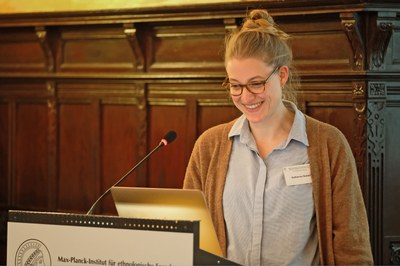Main Content
PhD projects at the Department of Middle Eastern Politics
Current PhD projects
Inhalt ausklappen Inhalt einklappen Clara Easthill: A comparative case study of the influences on Afghan resistance movements between 1979 and 2004.

C. Easthill Abstract:
Between 1979 and 2004, the Afghan central state underwent a number of noteworthy changes. After the invasion of the Soviet Union in 1979, several distinct phases of war impacted Afghanistan: From the initial fight, which saw many Afghans joining resistance movements against the Soviet forces and communist central state, to a civil war, to the Taliban regime, war defined the country’s development. After 9/11 and a renewed effort to drive out the Taliban, Afghanistan established a new governmental system with international (military and political) support. These decades of varying conflicts inflicted severe damages on the country and changed the political landscape within it, with political actors changing their roles and positions to adapt to the political context. Some of these actors, notably the Mujahideen, who had initially emerged as a resistance movement to the Soviet regime, mirror these changes:
The Mujahideen had initially emerged as guerrilla forces fighting the central state. There were distinct and often oppositional factions of Mujahideen who received varying levels of support. After the fall of the Soviet-supported Communist regime, the Mujahideen briefly governed the country in a coalition, while civil and factional war continued. Mujahideen factions then positioned themselves in different, often changing, ways towards the Taliban regime, and finally many played a central role in the emergence of the new state post 2001. This thesis aims to present an analysis of Afghan resistance movements between 1979 and 2004.
This thesis embeds the transformations of the state and the changing military-political role of the Mujahideen, into rentier theory. There are two main, connected, foci to this work: Firstly, the thesis aims to analyse the rent-seeking activities of the Mujahideen, showing which activities of the Mujahideen can be classified as rent-seeking and emphasising the effects thereof on the Afghan state and population. The second focus highlights the role of the international community within the conflict by analysing in which ways they incentivized and influenced these rent-seeking activities. By following these two research foci, the thesis aims to show the factors that contributed to Afghanistan’s fragmentation, the effects of which are noticeable until today. The underlying assumption is that the specific national and international context in which the wars arose, specifically the dominant rentierism, caused this fragmentation. The analysis will be carried out by comparing five case studies, i.e. five Mujahideen leaders who were active in the period under analysis. Their political and military activities, and changing roles, are analysed from a biographical and comparative perspective. Importantly, these activities include the relations of the Mujahideen to one another, with the central state and the (international) public.
Theoretically, the thesis follows the rentier approach, and the main methodology includes the Biographic Method as well as a comparative approach.
Contact: clara.easthill@uni-marburg.deInhalt ausklappen Inhalt einklappen Alexander Lohse: Status-seeking strategies of a rising regional power: The United Arab Emirates’ foreign policy since 2004
Inhalt ausklappen Inhalt einklappen Katharina Siebert: Collective Identity in Social Movement Organizations

This thesis focuses on the collective identity of social movement organizations (SMOs) and aims at discovering how the nature of a group’s collective identity affects the organization’s actions. By comparing the collective identities of case study organizations and tracing their development, this thesis tries to shed light on how variations of collective identity translate into differences with regard to their behavior, especially flexibility and change.
As this question has not been sufficiently answered by the existing theoretical research on social movements and SMOs, this thesis will firstly discover how variations of collective identity in SMOs can be identified and made comparable. To this end, a theoretical instrument will be developed in order to systematically assess the collective identity of a SMO. Secondly, this study will explore how variance with regard to collective identity affects the behavior of SMOs.Inhalt ausklappen Inhalt einklappen Humood Abdulrahman AlOtaibi: The State of Kuwait’s Humanitarian Diplomacy as a Tool of Soft Power: A Critical Assessment of Policy, Practice, and International Perception.

Abstract:
The research critically examines the role of humanitarian diplomacy in shaping the State of Kuwait's soft power strategy and foreign policy. Being a small state navigating in a volatile region, the State of Kuwait; especially post 1991 (Gulf War) has positioned itself as a global humanitarian leader and was given a high international status as a Humanitarian Center because of its foreign aid, mediation and multilateral partnerships as means for preventive diplomacy that fostered alliances and mitigated regional tensions.
The research analyzes how Kuwait concepts and projects a narrative of neutrality and generosity; and investigates the efficacy of this approach in achieving foreign policy objectives. It draws on a multi-theoretical framework that includes Soft Power Theory, Strategic Narrative Theory, Small State Theory, Constructivism, and Global IR. It will employ a qualitative, multi-case study methodology focusing on the State of Kuwait's roles in the GCC Crisis, Syria, Yemen and Iraq.
By discourse analysis, institutional mapping and interviews with international actors, the research will evaluate how Kuwait's humanitarian diplomacy is perceived and operationalized and it will contribute to both academic debates on soft power and practical policy discussions on the evolving strategies of Gulf small states in the global order. In doing so, the research will address a critical gap in literature highlighting how the role of small states (Kuwait) remains underexplored in mainstream international relations and soft power scholarship.
Keywords: Kuwait, humanitarian diplomacy, soft power, small state diplomacy, foreign policy.
Inhalt ausklappen Inhalt einklappen Mahitab Ali: Usufructal Colonialism and Subimperial Power: The UAE’s Port Investment and Sovereignty Erosion in the Red Sea.

Abstract:
The study examines the United Arab Emirates’ (UAE) strategic use of Red Sea port concessions and maritime infrastructure as instruments of usufructal colonialism—a mode of power initially deployed since 2006—securing long-term operational control without formal annexation. Unlike classical colonialism, this model leverages concessionary contracts and dual-use port agreements to entrench Emirati influence within the critical maritime infrastructures of fragile or crisis-prone states, eroding sovereignty under the guise of investment and development. Examining strategic Red Sea sites such as Doraleh (usufruct executed, subsequently unilaterally terminated) and Suez Canal–affiliated ports (usufruct operative), the study illustrates how these juridical and concessionary mechanisms recalibrate regional hierarchies and advance an Emirati influence-seeking strategy across the Red Sea corridor. Grounded in theories of extended state and neocolonialism, the study argues that Emirati economic statecraft in the Red Sea is not primarily revenue-driven, but geo-strategically oriented toward reshaping regional realities and projecting subimperial power. Methodologically, it employs a qualitative, comparative case study approach, combining legal analysis of usufructal contracts with expert narratives to trace how port control is co-produced with host regimes. In doing so, the study advances critical debates on subimperialism, infrastructure-led neocolonialism, and the political economy of sovereignty in the 21st century.
Keywords: UAE; usufructal-colonialism; port geopolitics; Red Sea; sovereignty erosion
Inhalt ausklappen Inhalt einklappen Zahraa Babaei: Water Conflict: Transition of Reconfiguration of a Rift ?

Abstract:
Over the past four decades, under the pressure of international sanctions and exclusion from the global market, the Islamic Republic of Iran has pursued a strategy of industrial and food self-sufficiency. To achieve this goal, policies such as dam construction and inter-basin water transfer were adopted, which placed heavy pressure on scarce water resources and involved diverting water from other regions. In recent years, the consequences of these policies have manifested in widespread social discontent, street demonstrations, damage to water facilities, and online mobilization.
This study focuses on the limitations of these protests in evolving into an effective civil movement. In fact, environmental protests, like any other form of resistance, are prone to co-option and integration into the status quo. Therefore, the present analysis critically evaluates water-related protests within the social context and power relations of an authoritarian structure. I argue that in the absence of modern institutions, traditional networks can play a dual role in organizing protests: while they provide the capacity for public mobilization, their undemocratic and ethnic nature poses serious challenges to the formation of a civic movement. Understanding the way these protests interact with structures of power sheds light on how authoritarian regimes reproduce themselves by exploiting the specific characteristics of their societies.
Keywords: Water Protests, Authoritarian Systems, Civil Movement, Co-option
Completed Dissertation Projects
Katrin Sold: Neue Mittelschichten in Nordafrika. Die Rolle junger Unternehmensgründer im politischen Transformationsprozess in Algerien, Marokko und Tunesien. (Disputation 27.11.2024)
Elyssa Jalloul: The Zeitouna Masters: Knowledge and the reconfiguration of the political field in Tunisia after 2011: The Zeitouna Mosque. (Disputation 25.01.2024)
Luíza Gimenez Cerioli: The Strategic Triangle in the Persian Gulf: dynamics of the relationship between United States, Iran and Saudi Arabia (Disputation 25.01.2022)
Nadia Abou Shady: The reconfigurations of the Egyptian Muslim Brotherhood post-2013 (Disputation 19.11.2021)
Christian Achrainer: Egypt’s External Alignments Post-2013: Regime Survival Amid Regional and Global Environments (Disputation 22.03.2021)
Thomas Jakob: Trade Unionism and the Institutional Equilibrium in MENA States. A Qualitative Comparative Analysis (QCA) supported Study of the Arab Upheavals 2011 – 2013 in Twelve Countries (Disputation 18.03.2021)
Manuel Sakmani: Interkommunitäre Kooperation in ethnisch-pluralen Gesellschaften: Schiitisch-maronitische Beziehungen und die Allianz zwischen Freier Patriotischer Bewegung und Hizbullah im Libanon (Disputation: 02.10.2020)
Taoufik Rached: Die politische Rolle der Mittelschichten in Marokko: Wandel oder Status Quo? (Disputation: 22.07.2020)
Julius Dihstelhoff: Handlungsstrategien deutscher Außenpolitik im Kontext der Umbruchprozesse in der MENA-Region seit 2011 mit Fokus auf moderat-islamistischen Akteuren - Fallbeispiel Tunesien (Disputation: 19.02.2020)
Christian Neugebauer: Economic liberalization and authoritarianism in the Middle East and North Africa: A comparative political economy of Egypt, Tunisia, Jordan and Morocco, 1950 - 2011 (Disputation: 20.01.2020)
Karolin Sengebusch: Die libanesische anti-konfessionelle Protestwelle 2010-2012: Formen, Strategien, Politikkonzepte. (completed 11/2017)
Jens Heibach: Oppositional Cooperation under Authoritarianism – The Case of the Joint Meeting Parties in Yemen (completed 12/2016)
Sabrina Bonsen: Eine politikwissenschaftliche Untersuchung zum Märtyrerkult im Libanon. (completed 6/2016)
Ali Sonay: Being Young and Political in Egypt: The Case of the April 6 Movement. (completed 1/2016)
Leandros Fischer: Der Israel-Palästina-Konflikt und die deutsche Linke am Beispiel der Partei DIE LINKE. (completed 2015)
André Bank: Regionale Kriege und lokale Ordnungen im Nahen Osten: Irak, Palästina und neue Herrschaftsformen in Jordanien. (completed 2010)